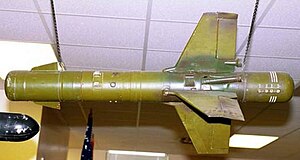Manual command to line of sight is a method for guiding guided missiles.

The BRDM-2 is an amphibious armoured scout car designed and developed in the Soviet Union. It was also known under the designations BTR-40PB, BTR-40P-2 and GAZ 41-08. This vehicle, like many other Soviet designs, has been exported extensively and is in use in at least 38 countries. It was intended to replace the older BRDM-1, and has improved amphibious capabilities and better armament compared to its predecessor.

The 9M14 Malyutka is a manual command to line of sight (MCLOS) wire-guided anti-tank guided missile (ATGM) system developed in the Soviet Union. It was the first man-portable anti-tank guided missile of the Soviet Union and is probably the most widely produced ATGM of all time—with Soviet production peaking at 25,000 missiles a year during the 1960s and 1970s. In addition, copies of the missile have been manufactured under various names by at least six countries.

The 3M6 Shmel is an MCLOS wire-guided anti-tank missile of the Soviet Union. Its GRAU designation is "3M6" and its NATO reporting name is AT-1 Snapper.

The 9K111 Fagot is a second-generation tube-launched semi-automatic command to line of sight (SACLOS) wire-guided anti-tank missile system of the Soviet Union for use from ground or vehicle mounts. The 9K111 Fagot missile system was developed by the Tula KBP Design Bureau for Instrument Building. 9M111 is the designation for the missile. Its NATO reporting name is AT-4 Spigot.

The 9M113 Konkurs is a Soviet SACLOS wire-guided anti-tank missile.

9K114 Shturm - is a SACLOS radio guided anti-tank missile system of the Soviet Union. Its GRAU designation is 9K114. Its NATO reporting name is AT-6 Spiral. The missile itself is known as the 9M114 Kokon (Cocoon).

The Nord Aviation SS.10 was a MCLOS wire-guided anti-tank missile designed by the French engineer Jean Bastien-Thiry. In American service, the missile was called the MGM-21A. The missile entered service in 1955 with the French Army. It was used briefly by the US Army in the early 1960s. The missile ceased production in January 1962 after approximately 30,000 missiles had been built.

The SS.11 is a French manual command to line of sight wire-guided anti-tank missile manufactured by Nord Aviation. It is also available in the air-to-ground version, AS.11, which featured a stabilized sighting system. The AS.11 was also known as the AGM-22 in American service. It is among the earliest guided anti-tank missiles, entering service with the French Army in 1956 and remaining in service into the 1980s. It also formed the basis for the larger and longer-ranged SS.12/AS.12 series.

The 9M120 Ataka is an anti-tank guided missile (ATGM) originating from the Soviet Union. The NATO reporting name of the 9M120 missile is the AT-9 Spiral-2. It is the next major generation in the 9K114 Shturm family. The missile has radio command guidance and is also a beam riding SACLOS. This missile's primary variant was designed to defeat tanks with composite armour and explosive reactive armor. The 9M120 Ataka system is often confused with the 9K121 Vikhr system, despite being different weapons systems developed by different companies. The former was designed by the KBM machine-building design bureau and manufactured by the Degtyarev plant. According to the Stockholm International Peace Research Institute, Russia exported the Ataka ATGM to Iran, Kazakhstan, and Slovenia.
The following is a list of ammunition fired by the 125 mm smoothbore gun series used in the T-64, T-72, T-80, M-84, T-90, PT-91, T-14 Armata, and other tanks derived from those designs, as well as the 2A45 Sprut anti-tank gun.

The BRDM-1 is a Soviet amphibious armored scout car. It was the first purpose-built Soviet reconnaissance vehicle to enter service since the BA-64 and was built on the chassis and drive train of the BTR-40 armored personnel carrier. It is the world's first mass-produced combat vehicle of its class.

The BTR-40 is a Soviet open-topped, wheeled armoured personnel carrier and reconnaissance vehicle. It is often referred to as the Sorokovka in Soviet service. It was eventually replaced in the APC role by the BTR-152 and in the scout car role by the BRDM-1.

The 9K112 Kobra is a SACLOS anti-tank missile system of the Soviet Union. It is fired from the 125 mm main guns of the T-64 and T-80 series of tanks. A newer design based on the same concept is the 9M119.

The 9M123 Khrizantema is a Russian anti-tank guided missile (ATGM). Khrizantema was designed to deal with current and future generations of main battle tanks and can also be used to engage slow and low flying aerial targets like helicopters. The 9M123 missile, and its associated guidance system, forms the 9K123 missile system.
The 2T Stalker, also known as BM-2T Stalker, is a Belarusian armoured vehicle. it is a part of the GM chassis and It never entered production.

The Sovremenny class, Soviet designation Project 956 Sarych (buzzard), is a class of anti-ship and anti-aircraft guided-missile destroyers of the Soviet and later Russian Navy. The ships are named after qualities, with "Sovremenny" translating as "modern" or "contemporary". Most of the ships have been retired from active service and one converted into a museum ship in 2018; as of 2021 three remain in commission with the Russian Navy with several in overhaul. Four modified ships were delivered to the People's Liberation Army Navy, and remain in service.

















